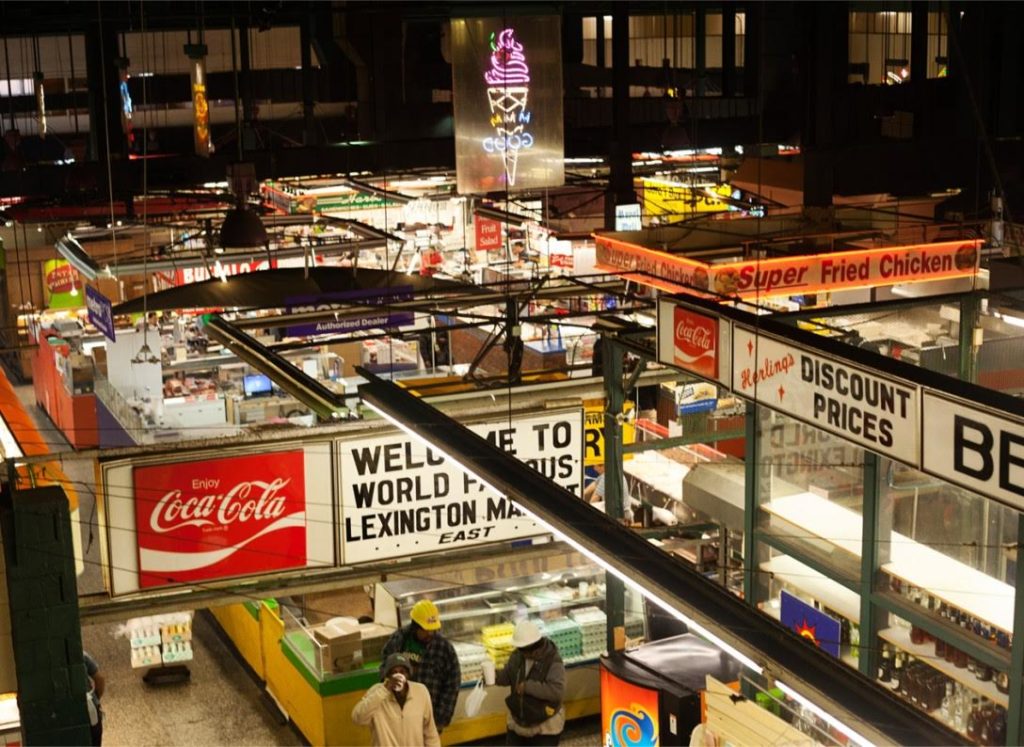[ad_1]

Lexington Market in Baltimore.
COURTESY LEXINGTON MARKET
For more than two centuries, Lexington Market has been one of Baltimore’s great meeting places, a jam-packed base of operations for hundreds of vendors, from butchers to produce specialists to fortune tellers. These days, it’s home to more than 50 businesses, including a bounty of different eateries, and beginning today they have a new neighbor: a branch of the Baltimore Museum of Art.
BMA Lexington Market, as the new venture is called, occupies 250 square feet in the market, which is located in the heart of the city, about two-and-a-half miles south of the museum. “Unlike museums, which move at sort of a self-consciously glacial pace, the idea with this is to be deeply responsive to need,” Christopher Bedford, the BMA’s director, said in an interview. “We want this to have the metabolism of a small, highly responsive not-for-profit that’s embedded in the community and listening to that community.”
The new branch, Bedford said, could operate as “an art space, an education space, a social-service space, an art-making space,” depending on feedback from those who visit. (The location will be open Thursday through Saturday, from 9 a.m. to 5 p.m. Admission is free.)
First up is a show of photographs by local young people who worked with Keith Calhoun and Chandra McCormick, New Orleans–based photographers whose gimlet-eyed pictures document life in Louisiana with a particular emphasis on the notorious Louisiana State Penitentiary at Angola. (An exhibition devoted to their work, “Slavery, The Prison Industrial Complex,” is currently on view at the Baltimore Museum of Art through October 27.)
Bedford framed the new location as part of his ongoing efforts to reshape the museum to better represent and serve the city of Baltimore, which is more than 60 percent black. “We have made every attempt to completely reorient the museum in all of its faces—trustees, exhibitions, acquisitions, public programs—all with a view to equity and diversity as our core values,” he said.
That initiative included selling off work by white artists well-represented in his collection, like Andy Warhol, Franz Kline, and Robert Rauschenberg, last year to raise funds to acquire art by people historically marginalized in its holdings, including black artists and women.

An installation view of works in the opening show at the new BMA Lexington Market branch.
MALAIKA AMINATA CLEMENTS
It’s not enough just to shift programming and expect a more diverse audience to show up, Bedford said. “I think the most important thing is to go where people are, and Lexington Market is so much a crossroad of all cultures in Baltimore. If you look at, on any given day, the demographics in and around the space, it represents the audience we want to engage.”
The BMA’s expansion comes as other museums have been opening new spaces or forming partnerships with other institutions in an attempt to reach new and more diverse audiences. From 2015 to 2017, the Rose Art Museum in Waltham, Massachusetts, ran a small space called Rosebud (a great name) in the city’s downtown, and last year, New York’s Bronx Museum unveiled plans to open in the Tribeca neighborhood of Manhattan. In Los Angeles, the Museum of Contemporary Art, which has two locations, has collaborated with the independent Underground Museum in the L.A. neighborhood of Arlington Heights since 2015.
The branch model has some precedents in the BMA’s history. The institution operated two branches in both the 1940s and the 1970s, and in 2015 came Outpost, a roving museum that made stops at—to quote a list of venues—“community gardens, farmers’ markets, retail spaces, libraries, supermarkets, health centers, and other gathering spots.” Bedford said that BMA Lexington Market grew out of comments from people who visited Outpost that they wanted permanent, sustained engagement beyond the grounds of the museum.
Lexington Market is open an hour later than the BMA satellite, so if you stop by late in the afternoon, you can cap off the visit with gargantuan oysters or fulsome crab cakes at Faidley Seafood, a hearty dose of chicken and waffles from Connie’s Chicken and Waffles, or a crisp new haircut at Perfect Gentlemen II.
[ad_2]
Source link

